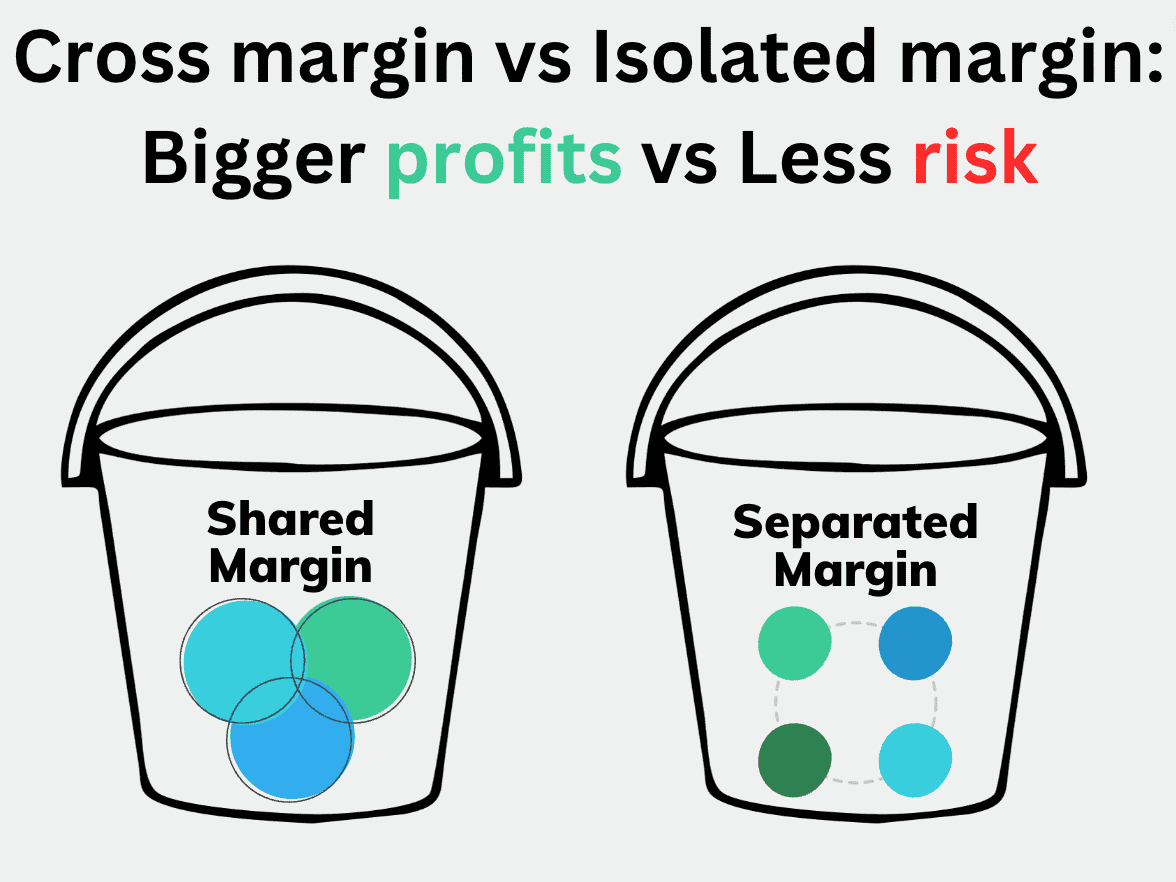If you are a crypto trader and recently got into crypto margin trading, you may have seen the option to choose between cross margin and isolated margin in your trading interface.
You’ve probably also asked yourself, what is it and what is the difference between cross vs isolated margin?
Since you’ve landed on this page, you’re in luck. Today we’re going to go through the in’s and out’s of this concept.
How does it work, what is the difference, and which option is best when it comes to making profits and controlling the risk?
Stick around and read to the end where I’ve added a comparison table for you to easily see the key differences which will help you choose the option for your crypto leverage trading strategy, let’s start!
Key takeaways from the article (TL;DR)
- Cross margin uses your entire account balance to support all positions, which adds flexibility and potential for higher profits but with higher risk. Isolated margin keeps each position’s margin separate, making it safer and easier to manage but with lower flexibility and profit potential.
- Cross margin allows for bigger trades and profits but can lead to total liquidation if things go wrong. Isolated margin limits losses to individual positions, adding better risk control but requires more active management and potentially lower profits.
- For less risk, beginners should start with isolated margin. It provides better risk management and helps you learn margin trading without risking your entire account on one bad trade. Gradually switch to cross margin as you gain experience.
The main differences laid out
Take a look at this comparison table to see the main differences:
| Feature | Cross margin | Isolated margin |
|---|---|---|
| Definition | Uses the total account balance to prevent liquidation of any position. | Uses only the allocated margin for each individual position. |
| Risk | Higher, as the entire account balance is at risk. | Lower, as only the allocated margin for each position is at risk. |
| Flexibility | High, as funds are shared across all positions. | Low, as each position’s margin is isolated and independent. |
| Margin calls | Affect the entire account, potentially causing liquidation of all positions. | Affects only the individual position, preventing a domino effect. |
| Complexity | Higher, due to the need to manage overall account risk. | Lower, with simpler risk management for each position. |
| Suitability for Beginners | Less suitable due to higher complexity and risk. | More suitable due to better risk control. |
| Capital efficiency | More efficient, as unused margin can be utilized by any position. | Less efficient, as unused margin is tied to specific positions. |
| Stop-loss impact | Stop-loss on one position can impact others due to shared margin. | Stop-loss on one position does not affect others. |
| Leverage | Leverage is applied to the total account balance. | Leverage is applied only to the margin allocated for each position. |
| Recovery from losses | Harder, as losses from one position can drain the entire account. | Easier, as losses are contained within individual positions. |
| Margin | Higher, as available margin can be utilized by other positions. | Lower, as each position’s margin is isolated and not shared. |
| Trade management | More difficult due to the need to monitor overall account health. | Easier, focusing on individual position health. |
What is cross margin?
Cross margin means that you use the entire account balance as margin requirement for each position you have open.
This means that all the money you have deposited in your account acts as risk capital to be used for potential losses to prevent liquidation of any single position.
Imagine that you have five positions open at the same time, with cross margin, your account balance is shared between all the five positions.
Should one of the positions start losing money, this money will be taken from your account balance, or the margin requirement, and less money will be available for the remaining four positions.
This increases the risk of a margin call and potential liquidation of your account should you run out of cash to support the positions.
The most important pros and cons
Pros
- More flexibility: It gives you much more flexibility when the margin is shared between trades when the market is going in your favor. This way you don’t have to control exactly how much capital goes into each trade.
- Access to more leverage: In leverage trading, the more margin you add, the more leverage you get access to. By freeing up your capital, you give yourself the option to use more leverage and therefore also bigger positions.
- Bigger profits: When you use the full potential of your account you set yourself up for bigger profits. Cross margin gives you the option to maximize your trading capital on each trade.
- Temporary risk relief: If one of your positions would take a short-term loss, cross margin will help you with reducing the overall risk of that position by providing more money as margin requirement. Once the trouble is over, the capital is returned to your account.
Cons
- Higher risk: The risk is overall higher with crossed margin due to the factor that all positions could together drag down your entire account at the same time.
- Risk of total liquidation: You run the risk of a total account liquidation since the capital is shared between positions. If the market is in freefall and you don’t stop the losses, you could potentially lose all your capital. It is also much more difficult to control the liquidation price of each position due to the shared margin.
- Can be hard to control: If all your positions start moving against you at the same time, it can be hard to decide which one to let go. It’s like having several ticking bombs in your hands without knowing which one will blow up first.
What is isolated margin?
Isolated margin keeps the margin requirement for each position separated which means that each position has its own margin requirement.
The potential loss from leverage is limited to the margin allocated to one single position. Most of the crypto margin trading exchanges listed in our review offer the option to use isolated margin.
Let’s say that you decide to use $250 as margin requirement to open a position, with isolated margin, your loss can never exceed this $250.
You could imagine it as each leveraged position has its own bucket of cash and the cash is never shared between trades, lowering the risk of margin calls and liquidations.
As you will see soon, this option limits your potential leverage but is much better for risk management while trading with margin.
Pros and cons
Pros
- Easier to manage risk: It is easier to control the risk for each position as you know exactly how much went into opening the trade. The total risk can never exceed the margin requirement.
- Easier to manage each trade: Since each trade is independent, managing them becomes much easier when you don’t have to think about several trades at the same time. This helps with calculating leverage, profits, and losses.
- Low liquidation risk: If you have 10 trades open, the risk of liquidation is limited to each position. Even if one gets liquidated, you still have nine more trades up and running. If you plan your risk well, you could see each liquidation as a stop-loss.
- Low margin call risk: Since each position has its own margin call, you can stay calm knowing that they won’t get margin called at the same time.
- Predictable losses: The potential loss for each position is limited to the margin capital allocated to that trade. This gives you great control over how much you stand to lose per trade.
Cons
- Less flexibility: Once you allocate margin for a position, that’s it. If the market quickly moves against you, you might get liquidated without adding more capital. This can be frustrating when the market moves fast.
- Lower profits in general: By spreading out the account capital on many positions it can be frustrating to see one position doing extremely well on less capital. This reduces profitability greatly if you have many trades live at the same time.
- Limited funds: You might be caught off guard by a great entry in one of your favorite markets while your funds are tied up to seven other trades at the time. You can either close your trades or wait for the next opportunity.
- Takes more trade management: You must indeed manage the trades more with isolated margin. Each position requires its own margin calculation before it is opened and if you are trading several markets at the same time this can be time-consuming.
Which one to use for less risk?
Isolated margin is the better option to lower the overall risk of your trading account if you are a beginner trader.
This is good because even if one position goes bad, it doesn’t affect your entire account.
Keeping the risk separated between positions gives you the calm you need when you are first starting out.
Start with isolated margin and see how you progress over a couple of weeks.
When you feel confident that you can handle the increased risk of crossed margin, make the switch gradually with small position sizes.


